
Trees and Beasts: Auspicious architecture and urban planning in Japan, past and present

Key information
- Date
- Time
-
5:00 pm to 7:00 pm
- Venue
- Russell Square: College Buildings
- Room
- 4429 (C429)
- Event type
- Event highlights
About this event
Throughout East Asia, great care was taken to select suitable locations for constructing tombs, residences, and cities in a set of practices that are generally grouped under the broad label of geomancy or telluric divination.
A site was considered auspicious if protected by four guardian creatures: the Black Turtle-Snake, the Vermilion Bird, the Azure Dragon, and the White Tiger. After a brief introduction to its Chinese origins and local transformations, this talk will address how geomancy affected the Japanese built environment over the centuries, ranging from ancient Chinese-style capitals over nineteenth-century Shinto shrines to contemporary architecture.
About the speaker
Dr Ellen Van Goethem specializes in the history and archaeology of the Asuka, Nara, and early Heian periods (the long 8th century). Her primary focus is on Kanmu Tennō, on the layout of Japan’s ancient capital cities, and on inscribed wooden tablets.
She has also published on site divination in premodern East Asia and on the influence of fengshui thought on contemporary Japanese architecture. Her current research, an institutional and social history of Heian Jingū, builds upon her earlier work. In this project, she investigates issues related to the reconstruction of long-lost buildings, the deification of emperors, the presence of Chinese cosmological symbolism in Shinto shrines, and changes in the perception of Heian Jingū since its founding in the late 19th century.
This event free, open to the public, and held in person.
- Organiser: SOAS Centre for the Study of Japanese Religion

